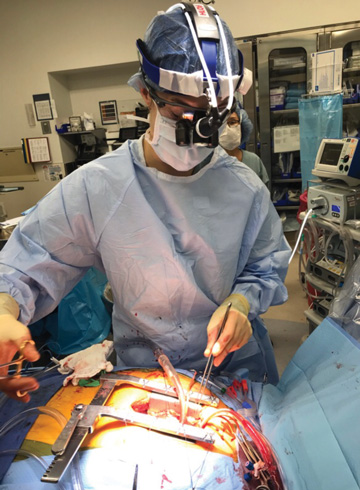• Helpful advice. Recognizing potential problems in real-time is one of the best ways to prevent future injuries, and these observation sessions have had a dramatic impact on the awareness Duke surgeons have of proper positioning
— as have the loupe-fitting changes that are part of the surgeon ergonomics program. Poorly fitted loupes that surgeons use to magnify and visualize the surgical field can cause them to bend their necks at awkward, uncomfortable angles
during surgeries, which often leads to strain injuries.
To remedy this common issue, Duke Health made some major changes to its loupe-fitting practices with the aim of helping the next generation of surgeons. To ensure interns are better educated on the proper way to wear loupes, residents were brought
in to consult with them prior to their fittings. “The residents guide the interns on what to look for in a fitting and how the loupes should fit, and that’s been really helpful because interns have been basing their decisions solely
on what the vendors told them,” says Ms. Pentico.
Interns are also given an opportunity to make modifications if they’re having problems with their loupes. “Within three months, the expectation is that interns will have a follow-up session with the vendor if they need to change the
fit,” says Ms. Pentico. “Vendors know they must be available to make the changes within that time frame.”
The location of the fittings has also undergone an overhaul, moving to a SIM lab with a height adjustable table, a training mannequin and suturing kits. The change, says Ms. Pentico, ensures interns are being fitted while they’re performing
a suturing task at a table height that they indicate is in line with what they typically use in the OR. The emphasis on proper fitting is crucial because of how long physicians spend with the equipment. “We have attendings who have been
wearing the same loupes for 15 to 16 years, so we need to get our interns started off right,” says Ms. Pentico.
• Regular breaks. Even if your facility doesn’t have the resources to invest in a formal ergonomics program, there are plenty of things your staff can do to protect themselves from injuries. Dr. Hollenbeck swears by
regularly stretching and performing exercises that are geared toward straightening muscles around the spine and flexing or extending his body back into more of an upright position. “Surgical team members are often bending over and forward
in order to see down into the patient during surgery, so they want to stretch the postural muscles in the back as opposed to the abdominal muscles,” he says.
Dr. Hollenbeck has also incorporated microbreaks into his surgical routine, short resets or stretches that occur every hour during longer cases. “Microbreaks let the team pause and perform the postural muscle exercises and activate muscles
in the neck,” he says.
If you work at a high-volume outpatient facility that strings together a series of shorter cases, Dr. Hollenbeck suggests dedicating some portion of the OR turnover time to limbering up and repositioning your body in a better way, even if it’s
just standing with your back against the wall and stretching out your arms.
One of the most important factors impacting proper ergonomics in the OR is the culture shift that is occurring right now. In the past, says Dr. Hollenbeck, surgical professionals didn’t talk much about ergonomics, proactive stretching and
preventing musculoskeletal injuries because they feared that admitting they were hurt or injured would impact opportunities to advance their careers. “Injuries weren’t discussed because people used to think that if you wanted to
be a surgeon, you had to accept that your body was going to pay for it,” says Dr. Hollenbeck.
Now organizations like Duke are shining a light on just how outdated and problematic the push-through-the-pain mentality truly is for surgeons, and it’s up to facility leaders to make proper ergonomics a priority in practice. OSM
.svg?sfvrsn=be606e78_3)

.svg?sfvrsn=56b2f850_5)